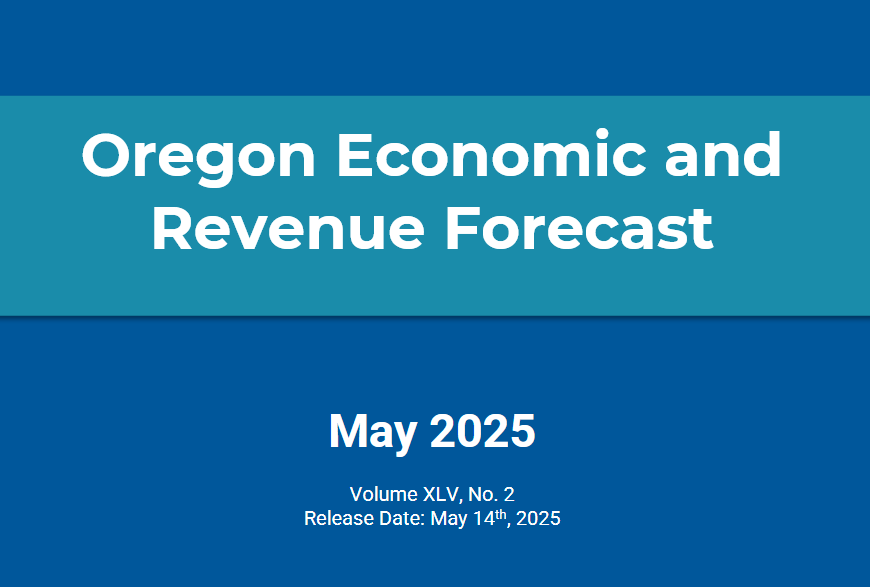Oregon Revenue Forecast Trims Expectations, But Resources Remain at Historic Highs

As Oregon lawmakers prepare to write the next two-year budget, the state’s economists are warning of mounting waves and shifting currents — an economy that is still afloat but taking on water. Earlier today, Oregon’s Office of Economic Analysis presented its final revenue forecast of the session, projecting slower growth, rising unemployment, and lower tax collections. Although they stopped short of predicting an official recession, the state is charting into a “growth recession,” an anemic period where the economy is not expanding quickly enough to balance labor conditions.
According to the forecast, much of the strain facing Oregon’s economic outlook stems from a murky national policy environment, where trade negotiations, federal layoffs and restructuring, and tax reforms remain in flux. Economists, like investors, are searching for meaningful patterns in a steady stream of announcements, reversals, and speculation that has complicated forecasting efforts. Still, they note the national economy has been more resilient than many expected, and consumer sentiment is beginning to stabilize. Additionally, over the last couple of weeks, effective tariff rates appear to be plateauing or pausing to accommodate trade deal negotiations. These conditions reinforce economists’ cautious optimism about avoiding a recession.
Oregon’s economic and revenue forecasts are based on both current state laws and assumptions about actions by the federal government. As in past cycles, federal policy and economic decisions often trickle down to the economic outlook of the states. During the trade skirmish in the late 2010s, federal tax cuts stabilized consumer spending and economic activity, which overtook other signs of slowing growth. Today’s forecast assumes a similar stabilizing effect from the tax changes currently under consideration in Congress. Specifically, the model assumes Congress will exempt tip and overtime pay from federal taxation and reduce the corporate income tax rate from 21 percent to 15 percent for businesses producing goods domestically.
Revenue Outlook Declines as Economic Growth Slows
Oregon’s revenue outlook has weakened since the last forecast, amid increasing economic crosscurrents and slower-than-expected personal income growth. The 2023–25 biennium, which concludes on June 30, is now projected to close with revenues down $162.3 million less than the previous forecast in February and a total ending balance of $2.17 billion. The economists attribute the decline primarily to lower income tax collections and softening business activity — trends already visible in real-time data such as estimated payments and withholdings. The personal income tax kicker, once estimated at $1.73 billion, is now expected to total $1.64 billion. That figure will be finalized this fall and distributed to taxpayers as a credit on their 2025 tax returns.
Looking ahead to the 2025–27 biennium, muted expectations for the broader economy point to a slower growth trajectory for state revenues. Overall, total state resources — excluding federal and other funds — are now projected at $37.41 billion, a decline of $755.7 million from the previous forecast.
The Big Picture
Oregon lawmakers will have fewer resources than the spring estimate, but the state’s overall revenue picture remains strong. Last November, state economists adjusted their forecasting model to reflect more optimistic assumptions — an effort aimed at maximizing projected revenues and avoiding the personal income tax kicker — which raised the estimate by $2.27 billion in a single forecast. While today’s announcement of a $755.7 million decline in the forecast is certainly notable, it remains relatively modest in comparison to that earlier upward revision.
As lawmakers look to craft their budget for the next biennium, they will have significantly more resources at their disposal than any other session. In kicker-adjusted terms — meaning gross revenues minus the amount refunded to taxpayers — the known available resources for the upcoming budget are $9 billion more than the previous budget cycle. The growth of Oregon’s resources over recent years is nothing short of jaw-dropping. During the 2013–15 biennium, the state forecasted $15.6 billion in General Fund revenues. Now, only a decade later, that figure has more than doubled to $37.4 billion.





